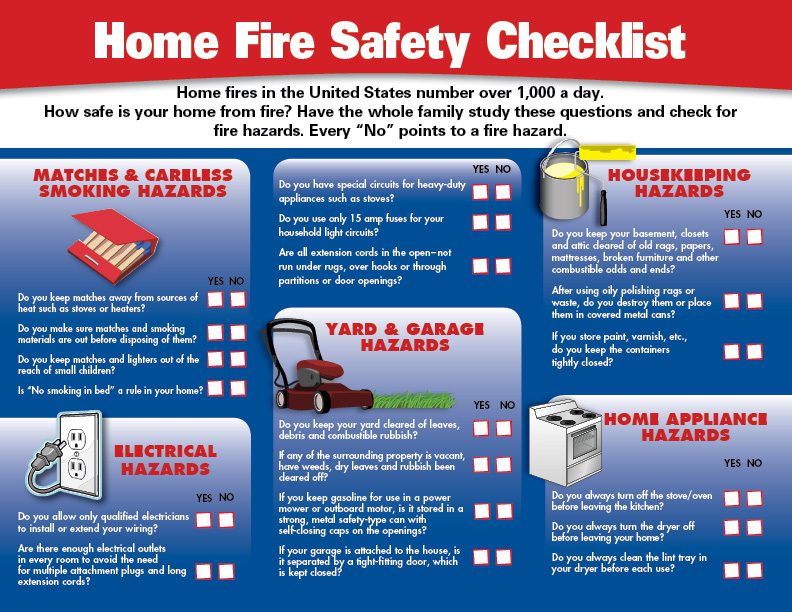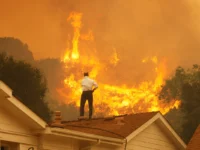Contents
- 1 Understanding the Importance of Fire Safety
- 2 Assessing the Fire Hazards in Your Home
- 3 Installing Smoke Alarms and Carbon Monoxide Detectors
- 4 Creating an Evacuation Plan
- 5 Educating Your Family on Fire Safety
- 6 Practicing Fire Drills Regularly
- 7 Maintaining Fire Extinguishers and Fire Blankets
- 8 Safe Storage of Flammable Materials
- 9 Regularly Inspecting and Maintaining Electrical Systems
- 10 Seeking Professional Help and Consultation
- 10.1 Consulting a Fire Safety Professional
- 10.2 Conducting a Home Fire Safety Audit
- 10.3 Getting Electrical Inspections
- 10.4 Receiving Training and Certification
- 10.5 Reviewing Insurance Coverage
- 10.6 Participating in Community Fire Safety Programs
- 10.7 Keeping Up with Fire Safety Standards
- 10.8 Addressing Specific Concerns
- 10.9 Related posts:
Home fire safety checklist – Fire safety is a crucial aspect of ensuring the well-being of your loved ones and protecting your home. In this article, we will provide you with a comprehensive checklist that covers all the essential steps you need to take to minimize the risk of fires and be prepared in case of an emergency. By following these simple guidelines, you can greatly enhance the safety of your home and gain peace of mind. Let’s dive right in!
Understanding the Importance of Fire Safety
Fires can cause devastating damage to homes and pose significant risks to the safety of individuals. Understanding the importance of fire safety is essential in taking proactive measures to prevent fires and protect your loved ones. By being aware of the potential risks and consequences associated with fires, you can develop a greater sense of urgency in implementing a comprehensive fire safety checklist for your home.
Protecting Lives and Property
The primary goal of fire safety is to protect lives and property. Fires can spread rapidly, engulfing an entire house within minutes. By adhering to a fire safety checklist, you can minimize the risk of fire-related injuries and fatalities, ensuring the well-being of your family and loved ones.
Preventing Costly Damages
A fire can wreak havoc on your property, leading to extensive damage and financial loss. From structural damage to loss of personal belongings, the aftermath of a fire can be overwhelming. Implementing fire safety measures can significantly reduce the likelihood of a fire occurring, thus preventing costly damages and the emotional toll that comes with rebuilding your life after a fire.
Complying with Legal Requirements
Fire safety is not only crucial for personal safety but also for legal compliance. Many jurisdictions have fire safety regulations in place that require homeowners to take certain precautions to protect their property and the surrounding community. By following a fire safety checklist, you can ensure that you are meeting these legal obligations and avoiding potential fines or penalties.
Promoting Peace of Mind
Knowing that you have taken proactive steps to safeguard your home and loved ones from the risks of fire can bring a sense of peace and security. By implementing a fire safety checklist, you can rest easy knowing that you have done everything within your power to reduce the likelihood of a fire and be prepared in case of an emergency.
Assessing the Fire Hazards in Your Home
Before you can effectively implement a fire safety checklist, it’s important to assess the fire hazards present in your home. By identifying potential risks, you can take the necessary steps to mitigate them and create a safer living environment.
Electrical Hazards
Start by examining your electrical system for any potential hazards. Look for frayed wires, overloaded outlets, or outdated electrical panels. Consider hiring a professional electrician to conduct a thorough inspection and address any issues that may pose a fire risk.
Flammable Materials
Take note of any flammable materials in your home, such as cleaning agents, gasoline, or propane tanks. Ensure that these items are stored properly in designated areas, away from heat sources, and in accordance with safety guidelines.
Heating Sources
Inspect your heating sources, including furnaces, fireplaces, and space heaters. Ensure that they are clean, well-maintained, and properly installed. Keep flammable items at a safe distance from these heat sources to prevent accidental fires.
Cooking Areas
Kitchens are common areas for fires to occur. Assess your cooking area for potential fire hazards, such as grease buildup, flammable kitchen towels, or unattended cooking appliances. Practice safe cooking habits, never leaving the stove or oven unattended while in use.
Smoking Habits
If there are smokers in your household, be aware of the fire risks associated with smoking. Ensure that smokers properly extinguish their cigarettes in designated areas and provide fire-safe ashtrays. Consider establishing a designated outdoor smoking area to minimize the risk of accidental fires.
Children’s Bedrooms
Children’s bedrooms should be evaluated for potential fire hazards as well. Keep flammable items, such as curtains or bedding, away from heat sources, and install smoke alarms in close proximity to these areas. Teach children about fire safety and the importance of keeping their bedrooms clutter-free.
Installing Smoke Alarms and Carbon Monoxide Detectors
Smoke alarms and carbon monoxide detectors are essential devices for early detection and alerting occupants of potential dangers. Proper installation and maintenance of these devices are crucial to ensure their effectiveness in protecting your home and loved ones.
Types of Smoke Alarms
There are different types of smoke alarms available, including ionization and photoelectric alarms. Ionization alarms are more responsive to flaming fires, while photoelectric alarms are better at detecting smoldering fires. Consider installing a combination of both types or dual-sensor alarms for comprehensive coverage.
Placement of Smoke Alarms
Install smoke alarms on every level of your home, including the basement and attic. Place them inside each bedroom, outside sleeping areas, and near common areas such as the kitchen and living room. Mount the alarms high on walls or ceilings, following the manufacturer’s instructions for proper placement.
Testing and Maintenance
Regularly test your smoke alarms to ensure they are functioning properly. Follow the manufacturer’s guidelines for testing frequency and replace batteries as needed, typically once a year. Additionally, vacuum the alarms periodically to remove any dust or debris that may interfere with their performance.
Carbon Monoxide Detectors
In addition to smoke alarms, it’s essential to install carbon monoxide detectors in your home. Carbon monoxide is a colorless and odorless gas that can be deadly if undetected. Install detectors near sleeping areas and follow the manufacturer’s instructions for proper placement and maintenance.
Interconnected Alarms
Consider installing interconnected smoke alarms and carbon monoxide detectors, which are wired together so that when one alarm is triggered, all alarms in the network will sound. This ensures that everyone in the house is alerted, even if the fire or carbon monoxide leak is in a different part of the home.
Testing Emergency Alert Systems
It’s also important to familiarize yourself with your local emergency alert systems. Test them periodically to ensure you are receiving notifications and alerts in case of a fire or other emergencies. Stay updated with the latest technology and systems available to enhance your home’s safety.
Creating an Evacuation Plan
An evacuation plan is a crucial component of fire safety. It provides a clear and organized strategy for everyone in your household to follow in the event of a fire emergency. By creating and practicing an evacuation plan, you can ensure the safe and swift evacuation of your home.
Identify Multiple Exit Routes
Identify all possible exit routes from your home. This includes doors, windows, and alternative escape routes such as basement or garage exits. Ensure that these routes are easily accessible and free from obstructions.
Assign Responsibilities
Assign specific responsibilities to each member of your household during an evacuation. This may include tasks such as assisting young children or elderly family members, gathering essential items like medications or important documents, or being the designated point of contact for emergency services.
Designate a Meeting Point
Choose a designated meeting point outside your home where everyone can gather after evacuating. This could be a neighbor’s house, a mailbox, or a specific landmark in your neighborhood. Having a predetermined meeting point allows you to quickly account for all family members and ensure everyone is safe.
Practice Regularly
Regularly practice your evacuation plan with your family members. Conduct fire drills at different times of the day and simulate various scenarios to ensure everyone knows what to do. Practice using different exit routes and reinforce the importance of staying calm and following the plan.
Consider Special Circumstances
If there are individuals with special needs or mobility limitations in your household, take their circumstances into account when creating your evacuation plan. Assign someone to assist them, and ensure that your plan accommodates their specific needs.
Review and Update the Plan
Periodically review and update your evacuation plan as needed. As your family dynamics change or your home undergoes renovations, reassess the plan to ensure its effectiveness. Communicate any updates or changes to all household members.
Inform Houseguests and Visitors
If you have houseguests or visitors, inform them about your evacuation plan upon their arrival. Provide them with clear instructions on what to do in case of a fire emergency and ensure they are familiar with the designated meeting point.
Educating Your Family on Fire Safety
Education plays a vital role in fire safety. By providing your family members with the necessary knowledge and skills, you empower them to take proactive measures to prevent fires and respond effectively in case of an emergency.
Teach Basic Fire Prevention Measures
Start by teaching your family members about basic fire prevention measures. This includes emphasizing the importance of not leaving lit candles unattended, keeping flammable materials away from heat sources, and practicing safe cooking habits.
Demonstrate Proper Use of Fire Extinguishers
Show your family members how to properly use a fire extinguisher. Explain the different types of extinguishers available and their appropriate uses. Practice using a fire extinguisher in a controlled setting so that everyone becomes familiar with the process.
Teach Emergency Exit Procedures
Ensure that everyone in your household knows the proper procedures for exiting the house in case of a fire. Teach them to check doors for heat before opening, crawl low under smoke, and cover their mouth and nose with a cloth if necessary.
Instruct on Calling Emergency Services
Teach your family members how to call emergency services in case of a fire. Make sure they know the emergency number for your area and what information to provide, such as their location and the nature of the emergency.
Explain the Dangers of Smoke Inhalation
Inform your family members about the dangers of smoke inhalation during a fire. Emphasize the importance of staying close to the ground, where the air is less toxic, and covering their noses and mouths with a cloth or towel if trapped in a smoke-filled area.
Discuss Escape Routes and Meeting Points
Discuss and familiarize your family members with the designated escape routes and meeting points outlined in your evacuation plan. Ensure that they understand the importance of following these routes and meeting at the designated location to ensure everyone’s safety.
Encourage Regular Safety Discussions
Encourage open discussions about fire safety within your household. Regularly review and reinforce fire safety practices and address any concerns or questions that may arise. This ongoing dialogue will help ensure that fire safety remains a priority for everyone.
Practicing Fire Drills Regularly
Regularly practicing fire drills with your family is a crucial aspect of fire safety. By simulating emergency situations, you can ensure that everyone is familiar with the evacuation procedures and can respond quickly and calmly in case of a fire.
Set a Schedule for Fire Drills
Establish a schedule for conducting fire drills in your home. Aim to practice at least twice a year, or more frequently if desired. Choose different times of the day to simulate both daytime and nighttime emergencies.
Sound the Alarm
When conducting a fire drill, make sure to sound the alarm to simulate a real emergency. This will help condition everyone to respond quickly and instinctively when they hear the sound of a fire alarm.
Practice Multiple Scenarios
During fire drills, simulate different scenarios to prepare your family for various situations. For example, practice evacuating from different rooms or designate specific escape routes to follow. This will help everyone become familiar with different exit paths.
Stay Calm and Follow the Plan
Emphasize the importance of staying calm and following the evacuation plan during fire drills. Remind family members to crawl low under smoke, touch doors to check for heat before opening, and proceed to the designated meeting point outside the home.
Assign Roles and Responsibilities
During fire drills, assign specific roles and responsibilities to each family member. This can include tasks such as assisting young children or elderly family members, grabbing essential items like cell phones or a fireproof safe, or ensuring that everyone has safely evacuated.
Review and Assess Performance
After each fire drill, take the opportunity to review and assess the performance of your family members. Identify areas for improvement and address any concerns or questions that may arise. This feedback will help refine your evacuation plan and enhance overall fire safety.
Keep Practicing and Stay Prepared
Fire drills should be an ongoing practice in your household. Regularly conduct drills to reinforce the procedures and ensure that everyone is prepared to respond effectively in case of a real fire emergency. With continued practice, your family’s response to a fire will become second nature.
Maintaining Fire Extinguishers and Fire Blankets
Fire extinguishers and fire blankets are essential tools to have in your home for tackling small fires. Proper maintenance and care of these devices are crucial to ensure they are in good working condition when needed.
Types of Fire Extinguishers
There are different types of fire extinguishers designed to combat specific types of fires, such as Class A, B, C, D, or K fires. Familiarize yourself with the types of extinguishers you have in your home and their appropriate uses.
Regular Inspections
Perform regular inspections of your fire extinguishers to ensure they are functioning properly. Check the pressure gauge to ensure it is within the recommended range and inspect the extinguisher for any signs of damage or corrosion.
Follow Manufacturer’s Guidelines
Read and follow the manufacturer’s guidelines for maintenance and operation of your fire extinguishers. This may include specific instructions for testing, recharging, or replacing your extinguishers at regular intervals.
Proper Storage
Store your fire extinguishers in easily accessible locations, away from heat sources and potential fire hazards. Ensure they are mounted securely on the wall or placed in designated areas where they can be easily reached in case of an emergency.
Training in Fire Extinguisher Use
Consider attending a fire extinguisher training course or providing training to your family members on how to properly use a fire extinguisher. This will familiarize everyone with the proper techniques and increase their confidence in using the device effectively.
Fire Blankets and Their Maintenance
Fire blankets are another important fire safety tool. Regularly inspect your fire blankets for any signs of damage or wear and tear. Follow the manufacturer’s guidelines for cleaning and storing them properly.
Replacing Extinguishers and Blankets
Keep track of the expiration dates or recommended replacement intervals for your fire extinguishers and fire blankets. If they are expired or damaged beyond repair, replace them promptly to ensure your fire safety equipment is up to date.
Safe Storage of Flammable Materials
Proper storage of flammable materials is crucial in preventing accidental fires and minimizing the risk of injuries or property damage. By following safe storage practices, you can significantly reduce the potential hazards associated with these substances.
Identify Flammable Materials
Start by identifying the flammable materials in your home. This can include items such as gasoline, propane, cleaning agents, paints, and aerosol cans. Be aware of the potential fire risks associated with these substances.
Store in Approved Containers
Always store flammable materials in approved containers specifically designed for their safe storage. These containers should be tightly sealed and labeled appropriately to indicate their contents.
Store in Well-Ventilated Areas
Flammable materials should be stored in well-ventilated areas to minimize the buildup of flammable vapors. Avoid storing them in confined spaces or near heat sources that can ignite the materials.
Keep Away from Heat Sources
Ensure that flammable materials are stored away from heat sources such as furnaces, water heaters, electrical panels, or open flames. Keep them at a safe distance to reduce the risk of accidental ignition.
Avoid Clutter and Obstructions
Keep storage areas free of clutter and obstructions to allow for easy access and to minimize the risk of accidental spills or ignition. Ensure that flammable materials are stored in designated areas away from heavy foot traffic.
Follow Safety Data Sheets (SDS)
Consult the Safety Data Sheets (SDS) provided by the manufacturers of flammable materials. These sheets contain important information about proper storage, handling, and disposal of the substances. Follow the recommended guidelines to ensure safety.
Secure Properly
Ensure that all flammable materials are properly secured to prevent accidental spills or unauthorized access. Use appropriate locking mechanisms for cabinets or storage areas to restrict access to these potentially hazardous substances.
Dispose of Properly
Dispose of flammable materials properly and in accordance with local regulations. Do not pour them down drains or dispose of them with regular household waste. Contact your local waste management facility for guidance on safe disposal methods.</p
Regularly Inspecting and Maintaining Electrical Systems
Faulty electrical systems are a common cause of house fires. Regular inspection and maintenance of your electrical systems are crucial in identifying potential issues and preventing electrical fires.
Hire a Professional Electrician
Consider hiring a professional electrician to conduct a thorough inspection of your electrical systems. They can identify any faulty wiring, outdated electrical panels, or other potential hazards that may pose a fire risk.
Check for Frayed Wires
Regularly inspect your electrical cords and outlets for any signs of frayed wires. Frayed wires can cause electrical sparks, leading to a fire hazard. Replace any damaged cords or repair them promptly to ensure safe usage.
Don’t Overload Circuits
Avoid overloading electrical circuits by plugging too many devices into one outlet. Overloading can cause overheating and increase the risk of electrical fires. Use power strips with built-in circuit breakers to prevent overloading.
Inspect Switches and Outlets
Check the switches and outlets in your home for any signs of damage or discoloration. Loose connections or damaged switches can create sparks and increase the risk of electrical fires. Repair or replace them as necessary.
Test Ground Fault Circuit Interrupters (GFCIs)
Test GFCIs regularly to ensure they are functioning properly. GFCIs are safety devices designed to protect against electrical shocks and ground faults. Follow the manufacturer’s instructions for testing and resetting these devices.
Upgrade Outdated Electrical Systems
If your home has outdated electrical systems, consider upgrading them to meet modern safety standards. Older systems may not be equipped to handle the demands of today’s electrical appliances, increasing the risk of electrical fires.
Install Arc Fault Circuit Interrupters (AFCIs)
Arc fault circuit interrupters (AFCIs) are devices designed to detect and prevent electrical sparks caused by damaged wiring or faulty connections. Consider installing AFCIs in your home to enhance fire safety.
Be Mindful of Extension Cords
Avoid using extension cords as a permanent solution for powering appliances or devices. If temporary use is necessary, ensure that the extension cords are rated for the intended purpose and are in good condition.
Seeking Professional Help and Consultation
If you have concerns about fire safety in your home, seeking professional help and consultation is highly recommended. Fire safety experts can provide valuable advice, conduct thorough inspections, and offer customized recommendations tailored to your specific needs.
Consulting a Fire Safety Professional
Consider consulting a fire safety professional who specializes in assessing and enhancing fire safety measures in residential properties. They can conduct a comprehensive evaluation of your home’s fire safety and provide expert recommendations.
Conducting a Home Fire Safety Audit
A professional fire safety audit involves a detailed assessment of your home’s fire risks, identifying potential hazards, and recommending specific measures to mitigate those risks. This can help you prioritize fire safety improvements effectively.
Getting Electrical Inspections
If you have concerns about your electrical systems or suspect potential electrical hazards, hiring a licensed electrician to conduct an inspection is crucial. They can identify any faulty wiring, outdated panels, or other electrical issues that may pose a fire risk.
Receiving Training and Certification
Consider enrolling in fire safety training courses or programs to enhance your knowledge and skills in fire prevention and response. Obtaining certifications such as CPR (Cardiopulmonary Resuscitation) and first aid can also be beneficial.
Reviewing Insurance Coverage
Consult with your insurance provider to review your homeowner’s insurance policy and ensure that it adequately covers fire-related damages and liabilities. Understand the terms and conditions of your policy, including any fire safety requirements or recommendations.
Participating in Community Fire Safety Programs
Engage with local fire departments or community organizations that offer fire safety programs and initiatives. These programs often provide valuable resources, educational materials, and opportunities for hands-on training in fire prevention and response.
Keeping Up with Fire Safety Standards
Stay informed about the latest fire safety standards and guidelines issued by relevant authorities. Regularly review and update your fire safety measures to align with these standards and ensure that your home remains compliant and well-protected.
Addressing Specific Concerns
If you have specific fire safety concerns, such as the presence of unique hazards or the need for specialized fire suppression systems, consult with professionals who specialize in those areas. They can provide tailored solutions that address your specific concerns.
In conclusion, implementing a comprehensive home fire safety checklist is essential for protecting your loved ones and safeguarding your property. By assessing fire hazards, installing smoke alarms and carbon monoxide detectors, creating an evacuation plan, educating your family, practicing fire drills, maintaining fire extinguishers and blankets, storing flammable materials safely, inspecting and maintaining electrical systems, and seeking professional help when needed, you can greatly enhance the fire safety of your home. Remember, fire safety is an ongoing process that requires diligence and regular maintenance. By prioritizing fire safety measures and staying prepared, you can minimize the risk of fires and ensure the well-being of your family. Stay safe, stay informed, and make fire safety a top priority in your home.

Passionate about preserving lives and protecting properties, John Sarver is a dedicated advocate for fire safety. With an unwavering commitment to educating and empowering communities, he has become a prominent voice in the field. As the founder and author of the influential blog “SarverFire,” John’s mission is to share invaluable insights, tips, and resources to enhance fire safety awareness and preparedness.





